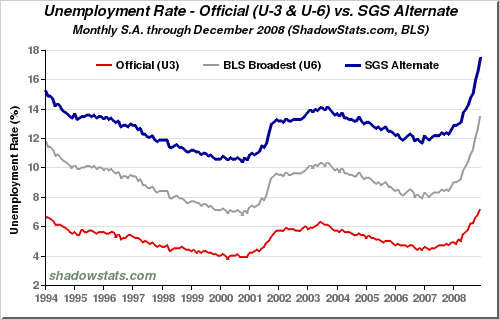Job losses continue to accelerate as thousands of workers lost their jobs today.
The latest numbers include:
CORNING INC 3,500
BOEING 5,500
STARBUCKS 6,700
AOL 700
FORD CREDIT 1,200
Job losses for the day totaled 17,600. Compared to 65,000 job cuts yesterday and considering that 143 million people are still employed in the US labor force, today’s job loss may seem minor. None the less, at a rate of almost 18,000 layoffs per business day, the annualized total of job losses in 2009 would amount to 4.5 million jobs. Total job losses last year came in at 2.1 million.
Companies that announce layoffs of up to 20% of the work force are not just fine tuning. The size of the job cuts being announced imply that businesses see an unprecedented and major reduction in future sales and profits.
Despite the obvious increase in job losses, official government estimates may be drastically understating the true unemployment rate. Consider the following:
The Birth/Death Model Defies Economic Reality
The birth/death adjustment made by the Bureau of Labor Statistics added over 900,000 new jobs last year when computing the unemployment rate. The model attempts to estimate new job formation caused by the birth and death of businesses. The model admittedly produces inaccurate numbers at economic turning points but we are far beyond that point. Last year’s addition of jobs based on the model were ridiculous and had zero correlation with economic reality. Accordingly, the official government statistics understated the unemployment rate last year due to the birth/death model distortions.
True Unemployment Rate May Be Twice The Government Numbers
The official unemployment rate may also be dramatically inaccurate based on the Bureau of Labor Statistics method of calculation. Consider the chart below from Shadowstats.com
If the government was still calculating the unemployment rate using the same criteria and methods that had last been used during the Clinton administration, the “official” unemployment rate today would be closer to 18%.
Courtesy of Shadowstats.com
The SGS Alternate Unemployment Rate reflects current unemployment reporting methodology adjusted for SGS-estimated “discouraged workers” defined away during the Clinton Administration added to the existing BLS estimates of level U-6 unemployment.
The economy is always about jobs. Regardless of the method of computation, the unemployment rate is growing dramatically. As the affects of layoffs and deleveraging continue to ripple throughout the economy, expect to see an official unemployment rate of over 10% in 2009.

![[Atlas Shrugged]](https://s.wsj.net/public/resources/images/ED-AI826_dgmoor_DV_20090108211701.jpg) Getty Images
Getty Images